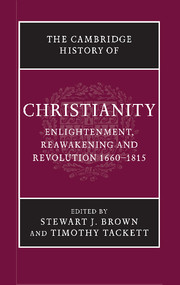Book contents
- Frontmatter
- Introduction
- PART I CHURCH, STATE, AND SOCIETY IN THE EUROPEAN WORLD, 1660–1780
- PART II CHRISTIAN LIFE IN THE EUROPEAN WORLD, 1660–1780
- PART III MOVEMENTS AND CHALLENGES
- 13 Christianity and the rise of science, 1660–1815
- 14 The Enlightenment critique of Christianity
- 15 The Christian Enlightenment
- 16 Jansenism and the international suppression of the Jesuits
- 17 Evangelical awakenings in the North Atlantic world
- 18 Toleration and movements of Christian reunion, 1660–1789
- PART IV CHRISTIAN DEVELOPMENTS IN THE NON-EUROPEAN WORLD
- PART V REVOLUTION AND THE CHRISTIAN WORLD
- Chronology
- Bibliography
- Index
- References
13 - Christianity and the rise of science, 1660–1815
from PART III - MOVEMENTS AND CHALLENGES
Published online by Cambridge University Press: 28 March 2008
- Frontmatter
- Introduction
- PART I CHURCH, STATE, AND SOCIETY IN THE EUROPEAN WORLD, 1660–1780
- PART II CHRISTIAN LIFE IN THE EUROPEAN WORLD, 1660–1780
- PART III MOVEMENTS AND CHALLENGES
- 13 Christianity and the rise of science, 1660–1815
- 14 The Enlightenment critique of Christianity
- 15 The Christian Enlightenment
- 16 Jansenism and the international suppression of the Jesuits
- 17 Evangelical awakenings in the North Atlantic world
- 18 Toleration and movements of Christian reunion, 1660–1789
- PART IV CHRISTIAN DEVELOPMENTS IN THE NON-EUROPEAN WORLD
- PART V REVOLUTION AND THE CHRISTIAN WORLD
- Chronology
- Bibliography
- Index
- References
Summary
The period from 1660 to the beginning of the nineteenth century was distinguished not only by significant technical and scientific progress, but also by the spread of a new way of thinking that drew for its effectiveness on scientific reasoning. English intellectuals such as Samuel Clarke were inspired by Newton’s Philosophiae naturalis principia mathematica (1687), while the huge impact of Leibniz’s Essais de Théodicée (1710) was due largely to the author’s mathematical knowledge. In France, the Encyclopédie (1751–72) represented not only an inventory of modern science, but an initiation into a new method of analysis, which was applied to the entire range of physical and metaphysical phenomena. That, indeed, was how d’Alembert, writing in his Discours préliminaire to the Encyclopédie, explained the sub-title of the Dictionnaire raisonné des sciences, des arts et des métiers.
Christianity, in principle, was not hostile towards scientific thought. Had not Saint Augustine written in his On Christian Doctrine, ‘All the sciences fight on behalf of the Christian religion’? Many theologians – such as Nicholas of Cusa at the close of the Middle Ages – had been passionate practitioners of mathematics. During the sixteenth century, all universities, both Catholic and Protestant, taught mathematics. From 1550 on, the secondary schools of the Society of Jesus, founded in the part of Europe still faithful to the Roman Church also did so, and this new religious order played an important role in the teaching of mathematics during the period of the Catholic Reformation. Nevertheless, there was a boundary beyond which neither Luther nor the papacy could step: the teachings of the Bible, whether scientific or theological, could in no way be questioned.
- Type
- Chapter
- Information
- The Cambridge History of Christianity , pp. 249 - 264Publisher: Cambridge University PressPrint publication year: 2006
References
- 1
- Cited by



